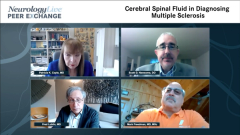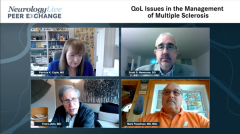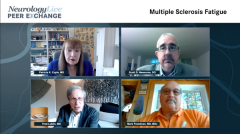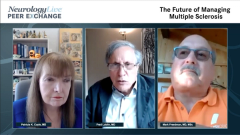
The Future of Managing Multiple Sclerosis
Episodes in this series

The panel sums up the future of managing multiple sclerosis, including the need for individual prognostication, neuroprotective agents, combination therapy, and the possible use of bone marrow transplantation.
Fred Lublin, MD: This has been a great discussion. Let’s close out with some thoughts for the future. What does the future hold for managing multiple sclerosis [MS]? Pat, why don’t you start?
Patricia K. Coyle, MD: In the United States, we have 25 distinct agents for relapsing forms of MS covering 10 mechanisms of action. What we don’t have are a lot of treatments for the neurodegenerative phase of MS and progressive MS. That is an ongoing key focus, and it’s very likely that neurodegeneration has to be hit from the earliest time point, ideally even before there is clinically apparent progression. We’re going to see a real emphasis on that.
In addition, we do not have any meaningful CNS [central nervous system] repair strategies, including re-myelinization and cell-based strategies to induce axonal sprouting. We just had a very disappointing failure of opicinumab. That’s off the table, with regard to CNS repair. This is a focus. It’s very promising that we have multiple studies in MS looking at CNS repair, but that’s a big deficit. We need CNS repair. We need neuroprotection agents. We need progressive MS agents. We need neurodegenerative strategies. They need to employed early. We need to make sure we are promoting wellness programs and the recognition of how bad comorbid conditions can be in MS, so that they’re identified and optimally managed. With that, the MS individual will age better.
Fred Lublin, MD: Excellent. Mark?
Mark Freedman, MD, MSc: As always, Pat, you’re so eloquent. You cover everything, and there’s very little to add, but I will add a couple of facts. One is that although we’ve talked about high-efficacy therapies, we haven’t talked about the highest-efficacy treatment. That is full-on bone marrow transplantation, which is becoming a bit more common across the world. People are recognizing its benefit in a select group of patients who have early, aggressive disease. They have a study going on in the United States, which will no doubt prove it is better than any of the other higher-efficacy therapies when appropriately applied to the right patient group. That’s an option that is still on the table for certain types of people.
The second is the evolving use of a biomarker to inform our outcomes. Neurofilament light [NFL] has gone beyond an experimental type. Maybe we should do it, and maybe not. It should be commonplace. These assays are readily available. They’re giving you some information about what kind of axonal damage is occurring under the water. In the appropriate patient who is young and has no confounders that might lead to the destruction of axons, neurofilament light is cheap and easy to do. It’s a blood test. You can do it on a regular basis and get at the entire brain.
The MRIs of the brain are done routinely. You get a bit of the spinal cord and the cervical spine, but if there’s damage anywhere, it will give rise to the axonal loss that you can measure with the NFL. That’s a biomarker moving forward, which you’ll see adopted quite readily. That’s another piece that can help inform, not only on prognosis, because we’ve seen those data, but also on monitoring treatment response.
That’s what I see moving forward. There’s 1 other thing that I want throw in there for good measure. Unfortunately, Scott Newsome had to leave. He talked about this 90% suppression of gadolinium [Gad]-enhancing lesions. That’s good. You and I both know, Fred, that there was another study that led to almost 90% suppression of Gad-enhancing lesions. That’s when interferon beta and teriflunomide were combined. They produced that same 90% suppression using 2 drugs that are relatively safe. Maybe the future for combination therapy should at least be explored.
Fred Lublin, MD: I don’t think I have much to add to what you both said. But I’ll throw in this idea of wanting to have individual prognostication. We’re good at prognosticating for groups, and we’re terrible at prognosticating for individuals. Biomarkers may be a part of that, but we need to build some individual metrics for a given individual, which will then inform our choice of therapies.
Thank you for this rich and important discussion. Thanks to our viewers for watching this NeurologyLive® Peer Exchange. If you enjoyed the content, please subscribe to their e-newsletters to receive upcoming Peer Exchanges and other great content right in your in-box.
Mark, Pat: Thank you very much.
Newsletter
Keep your finger on the pulse of neurology—subscribe to NeurologyLive for expert interviews, new data, and breakthrough treatment updates.



































